On January 19, a mandate to divest TikTok will take effect. Despite several attempts by ByteDance’s legal team, the Supreme Court has not provided clear support.
This means that starting January 19, major app stores will cease supporting TikTok, and ByteDance has announced plans to gradually shut down the app without selling it.
For American users who practically ‘live’ on TikTok, it feels like losing their home. So, they’ve begun a massive digital migration, searching for the next social media platform to call their own.
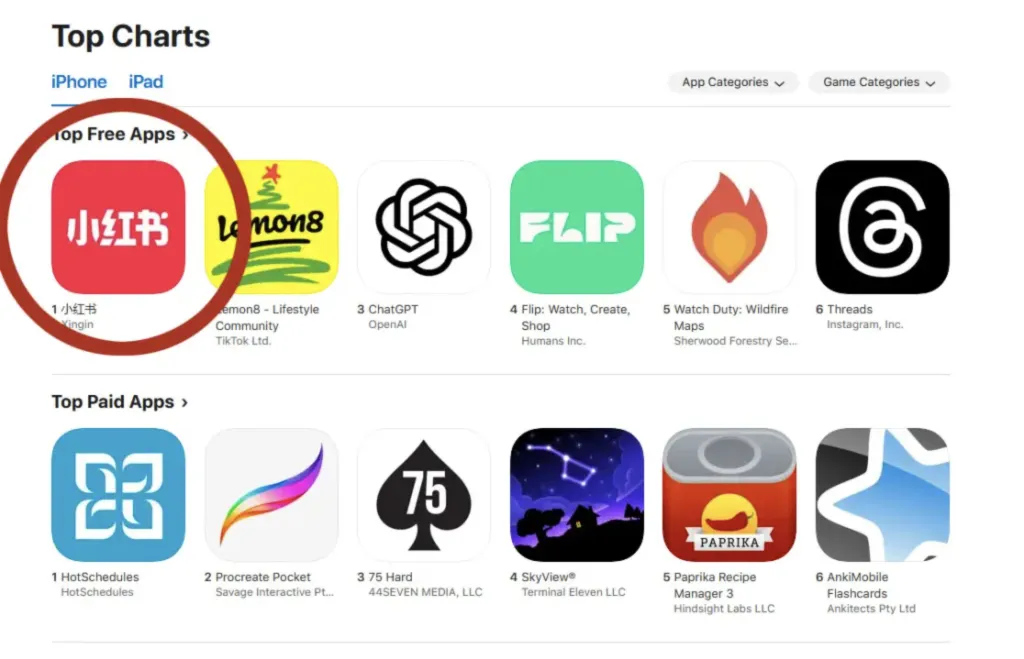
A mysterious force has propelled RedNote to the forefront. In the early hours of January 14, RedNote’s download ranking in the U.S. App Store soared to number one, surpassing ChatGPT and ByteDance’s Lemon8.
The massive influx of traffic was unstoppable.
Is This the RedNote I Know?
The first to be surprised were RedNote’s Chinese users. They noticed a sudden influx of English content on the platform.
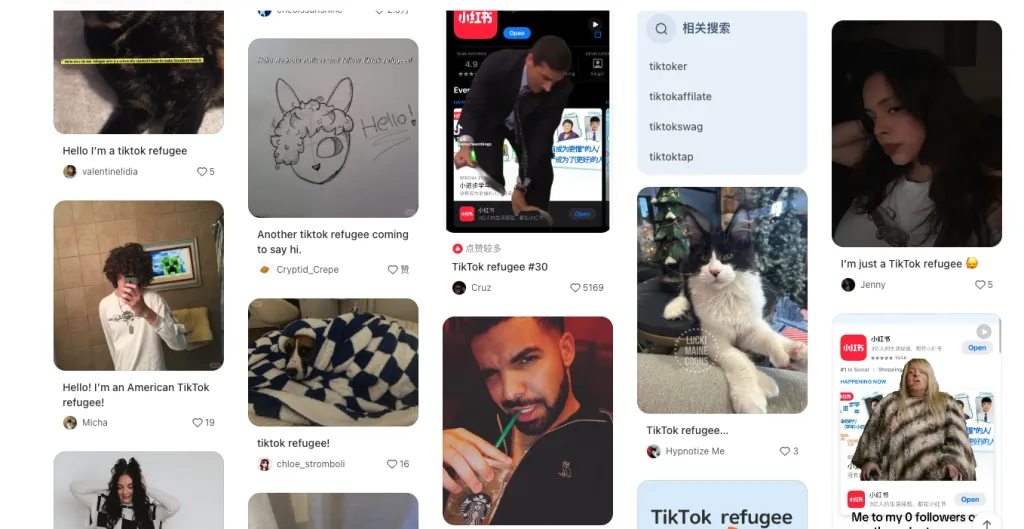
Upon closer inspection, why are Americans learning Chinese?
A large number of American users flocking to RedNote first need to overcome the language barrier. While system settings can be changed, not understanding the content of posts significantly reduces the fun.
Some users painstakingly copy and paste comments into GPT for translation, then use it to translate their replies.
RedNote should thank the times; without GPT, this wave of traffic might not have arrived.
Of course, Chinese users, known for their warmth and openness, immediately began teaching in the comments section.
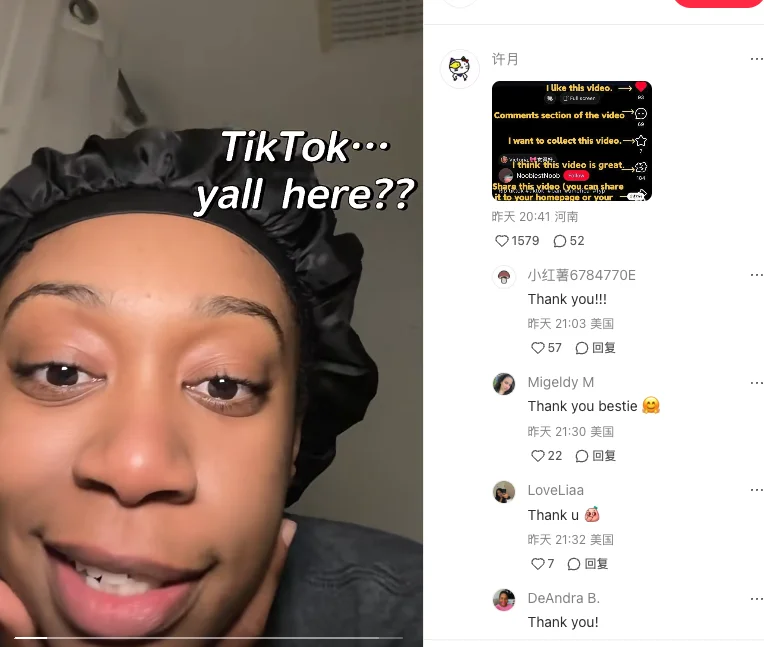
Many enthusiastic users are urging RedNote to quickly launch a one-click translation feature. If not now, then when?
Entering the “tiktokrefugee” topic now reveals various “refugee self-introductions,” with some savvy users even uploading cat photos to submit Cat Tax.

Indeed, cats are the universal magic of all social media. Everyone loves to see them, so keep them coming.
Interestingly, these American users love uploading photos right away, akin to real-name internet access, reminiscent of our early internet chat experiences 20 years ago.

While onlookers are still playing with memes, clever Chinese users have already taken action. The comments section is filled with English cloze test questions, providing a solution for winter break homework.

It’s not teaching English to Chinese for free—Chinese people can help them with math problems in return!

The meme collections by netizens have found their place. Don’t underestimate the American people’s abstract humor skills.
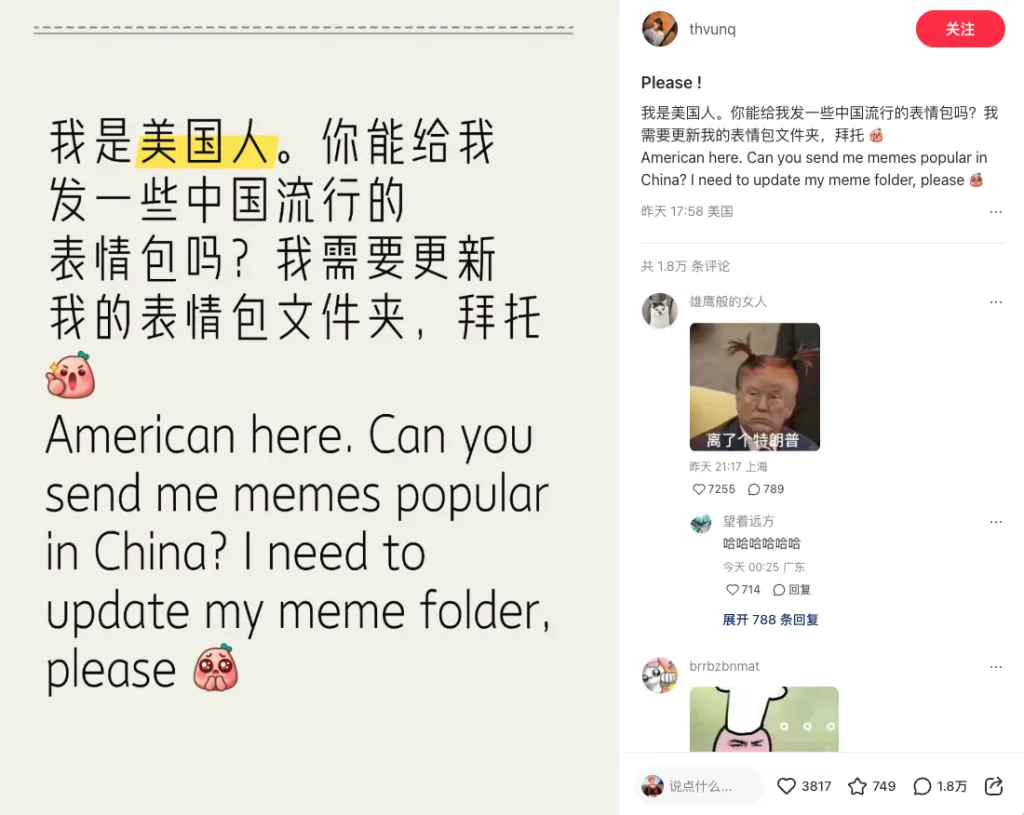
The current state of RedNote is like the meme below:

By the way: in the brightly lit headquarters of RedNote in Shanghai, is anyone still concerned about the well-being of the operations team?

Although everyone jokes about being TikTok refugees, hold on, this might be the real TikTok refugee, ByteDance.
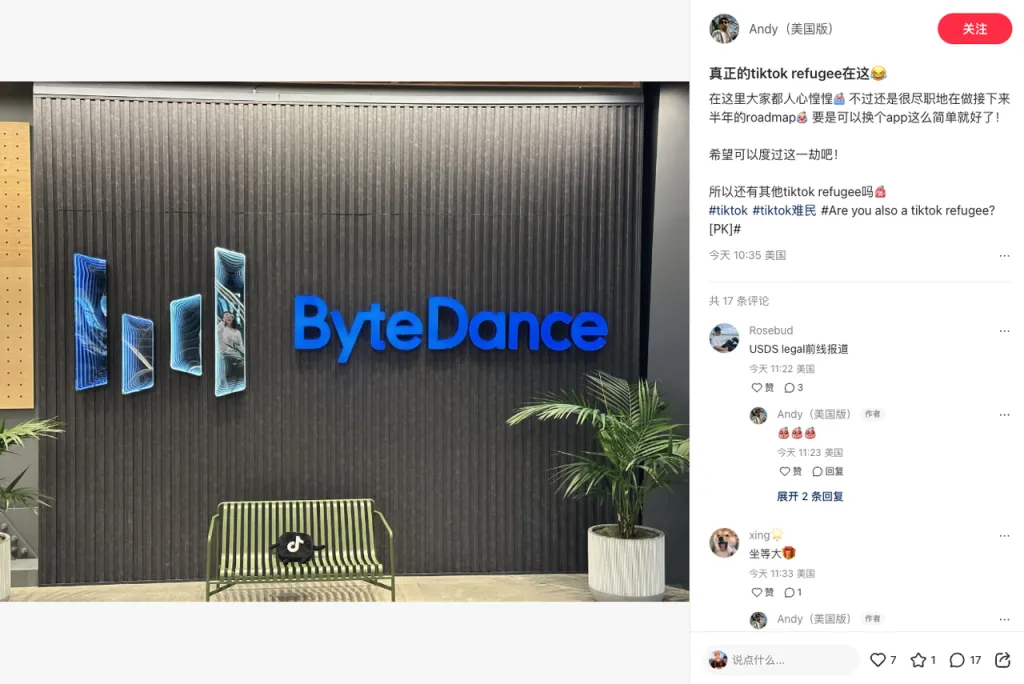
In the countdown before TikTok was banned, many netizens visited RedNote, then rushed back to TikTok to leave five-star reviews. They teach Chinese English homework while Chinese teach them Mandarin.

The earlier group of netizens on RedNote has already mastered the “V me ¥50” Chinese meme.

The influx of international users will undoubtedly impact the homepage experience of Chinese users. However, some friendly international users kindly explain the reasons, maintaining a strong sense of boundaries.
Who would have thought that a Chinese platform originally focused on product reviews would one day become a new hub for cultural exchange between Chinese and American netizens? The greatest charm of the internet might be just that—always full of surprises, yet so natural.
It Really Can Only Be RedNote
Why did RedNote become the biggest winner? You might have seen many analyses. Justine Moore, a partner at a16z, also collected some opinions.
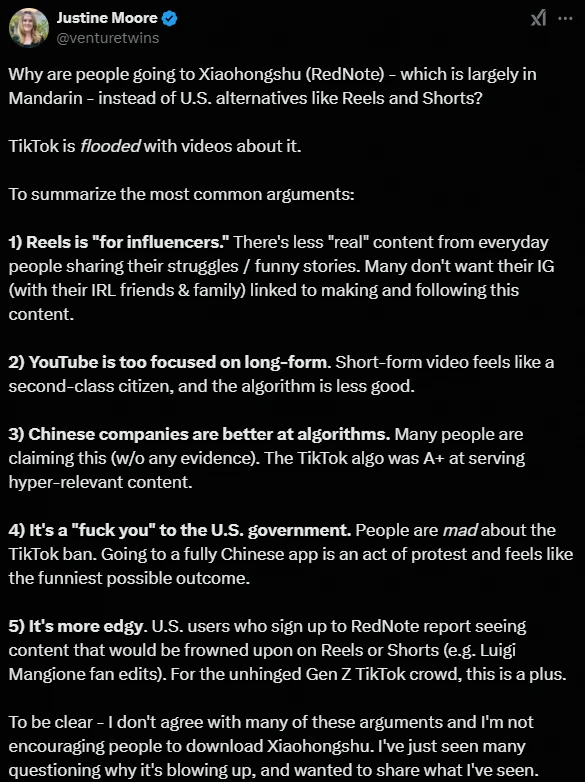
Some of these opinions make sense. For example, the differences with YouTube, or Reels—this platform has never won over some American users.

Reels was pushed to the forefront during TikTok’s first ban. Zuckerberg launched this product to capture the market, but it was never well-managed, making it difficult to be of much use today.
As for Lemon8, it was simply ByteDance’s attempt to replicate RedNote in the English market. It was heavily promoted but never took off.

Some opinions don’t hold up well, such as the unproven claim of Chinese companies’ expertise in algorithms.
RedNote’s rise is indeed due to some coincidental objective conditions:
conveniently, RedNote doesn’t have regional restrictions in app stores;
conveniently, international phones can register freely;
conveniently, RedNote’s video interface resembles TikTok;
conveniently, RedNote has perfected its recommendation algorithm.
Before considering why RedNote became “the one,” first consider why it became an option. These are the objective conditions. These conditions are more important than imagined—platforms that only accept Chinese phone numbers don’t even have a chance to compete.
How strong is Rednote’s recommendation algorithm? Americans might not know, but we do. Even while writing this article, my colleagues’ homepages have become remarkably similar due to collaborative filtering. A colleague who enjoys theater and musicals is now being recommended content from musical bloggers.
In fact, TikTok’s success in the U.S. was largely due to its powerful recommendation algorithm, which introduced a new approach: before this, the first generation of social media led by Facebook was based on connections with acquaintances. Even Instagram didn’t stray from this network of familiar contacts.
TikTok broke away from the existing network of acquaintances and pioneered the “content recommendation” path. This model is now deeply ingrained in the minds of young users, so much so that when TikTok faced potential shutdown, users sought alternatives with the same mindset: show me what I like, push more content, and don’t worry about who’s in my contact list.
In 2022, RedNote designed the CB2CF method, which estimates collaborative filtering results through content information. It only uses content as input, allowing the model’s generalization ability to yield good results even for new content.
Overall, it helps users broaden their interests rather than narrowing them down, and it effectively provides long-tail exposure for niche and unique content.
This is definitely not an “unproven” recommendation capability but rather a solid technical accumulation. Besides TikTok and Douyin, RedNote is the only one on this path.
Cyber Wanderers, Just to Find Real People
Technology is technology, but it’s also meant to serve user experience. The personal experiences of “refugees” are more direct and clear.
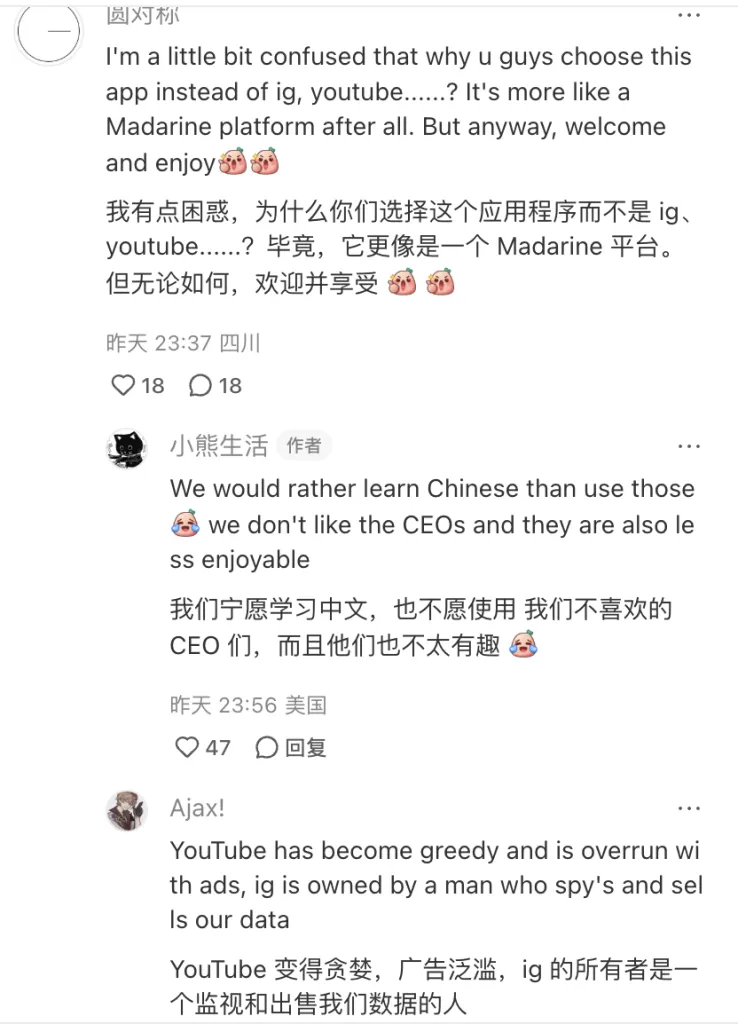
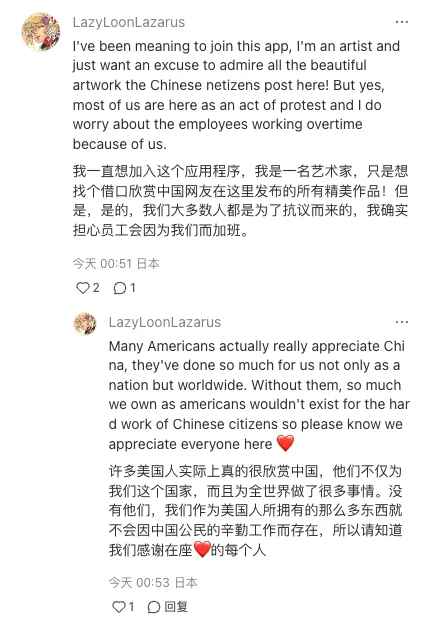
Honestly, it’s not to dampen Americans’ enthusiasm, but RedNote isn’t a utopia. Selling products and advertising are the main monetization methods on this platform, similar to Instagram.
However, RedNote is indeed a platform with a strong “organic” feel.
An accurate recommendation algorithm is just the first step. What truly makes a platform or a mechanism addictive is that these algorithms consistently bring in a lot of “real people.”
During this welcome process for “TikTok refugees,” not only ordinary users but also some brand official accounts joined in, enhancing the sense of real people.

Many might have forgotten: the last time such a global gathering of languages happened was on a platform called Clubhouse.
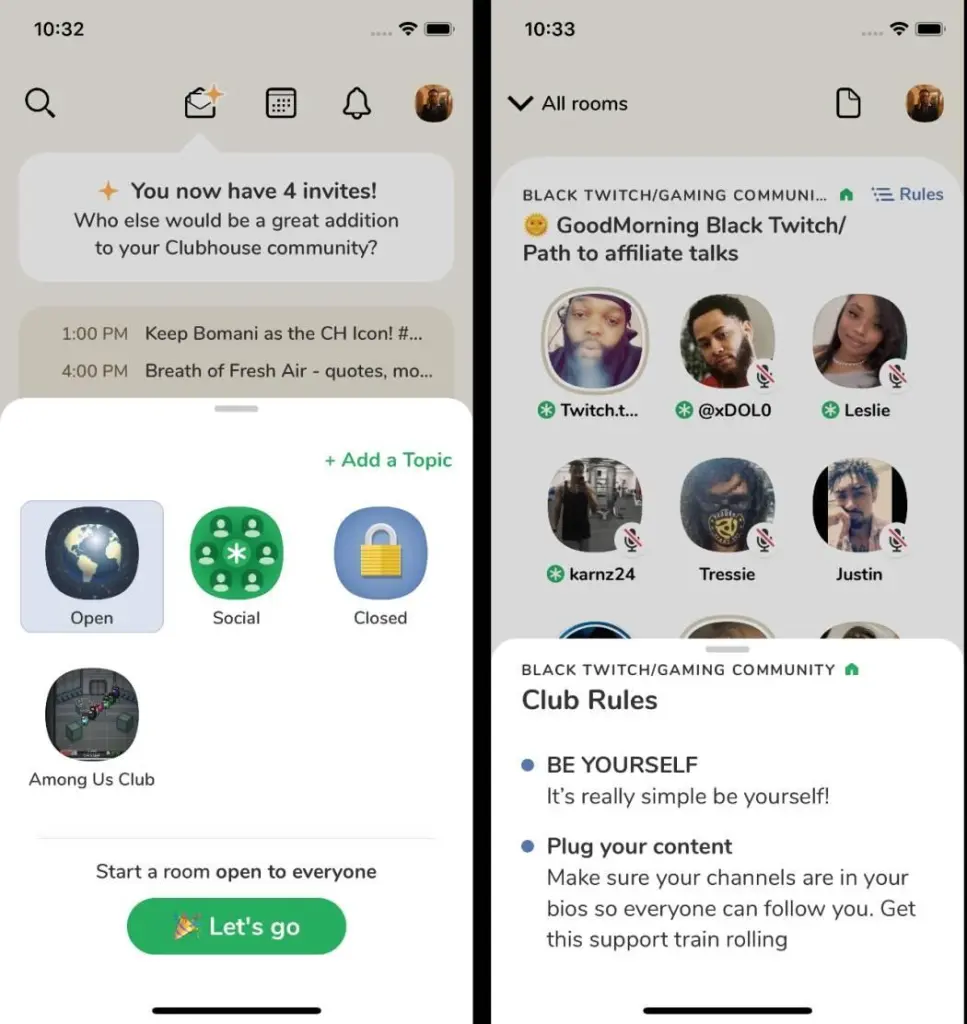
Clubhouse became popular during the global lockdowns caused by the pandemic, as people stuck at home discovered the platform. At the time, even big names like Elon Musk and Andreessen Horowitz supported it.
Unfortunately, Clubhouse’s peak was short-lived, but the “global village” feeling it once brought was genuine. Rooms were filled with enthusiastic strangers speaking different languages and from different backgrounds—a true sense of “real people.”
Social media has been around for decades and is an indispensable part of all internet users’ lives. We are accustomed to this hybrid form of expression with text, video, images, and emojis, and we can confirm the presence of real people on the other end of the internet through these texts.
“We express emotions and closeness, and our willingness to entertain others is to show that we are real, friendly, and enjoy communicating with them,” wrote communication scholar Nancy Baym in her classic book “Personal Connections in the Digital Age.”
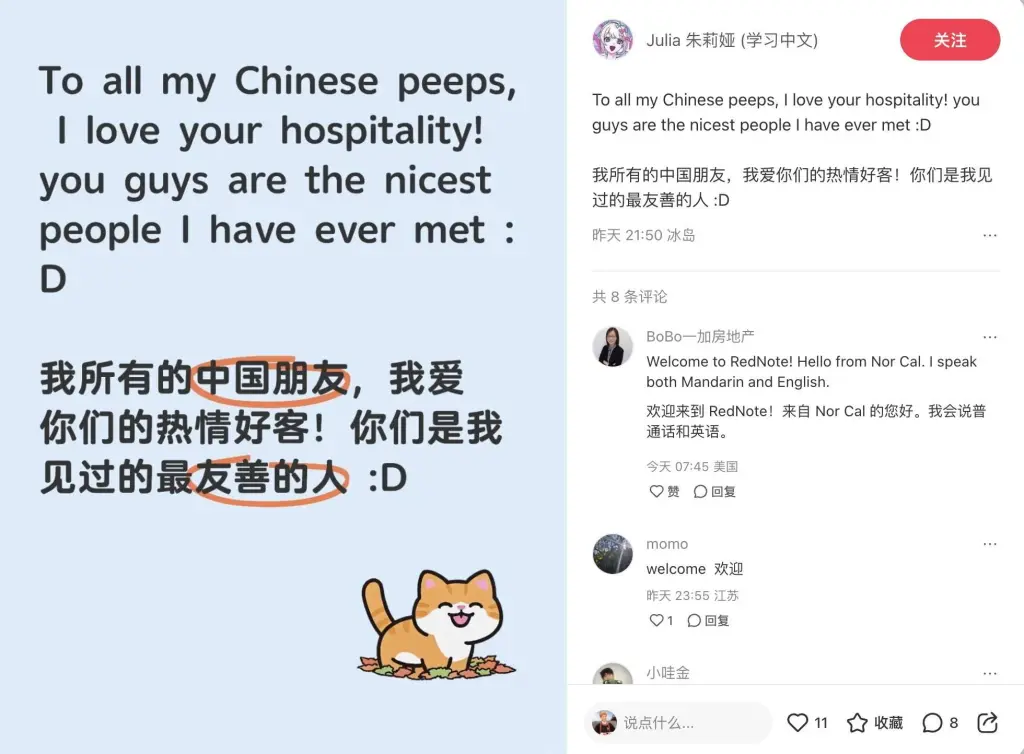
And this is precisely what everyone in this cyber migration has demonstrated.
Only by understanding the “real people” aspect can we understand why TikTok’s ban could provoke such a strong rebellious sentiment, leading to a massive cyber migration. TikTok was once the most “real people” community in English social media, where users’ experiences were genuine, not dictated by a “big brother.”
Good algorithms keep users, but real people make them stay. A platform’s vitality lies not in how well it speaks, but in how many people are willing to speak.
Who doesn’t love listening to real people? It’s pleasant, engaging, and we want to hear more.
Source from ifanr
Disclaimer: The information set forth above is provided by ifanr.com, independently of Chovm.com. Chovm.com makes no representation and warranties as to the quality and reliability of the seller and products. Chovm.com expressly disclaims any liability for breaches pertaining to the copyright of content.





 বাংলা
বাংলা Nederlands
Nederlands English
English Français
Français Deutsch
Deutsch हिन्दी
हिन्दी Bahasa Indonesia
Bahasa Indonesia Italiano
Italiano 日本語
日本語 한국어
한국어 Bahasa Melayu
Bahasa Melayu മലയാളം
മലയാളം پښتو
پښتو فارسی
فارسی Polski
Polski Português
Português Русский
Русский Español
Español Kiswahili
Kiswahili ไทย
ไทย Türkçe
Türkçe اردو
اردو Tiếng Việt
Tiếng Việt isiXhosa
isiXhosa Zulu
Zulu